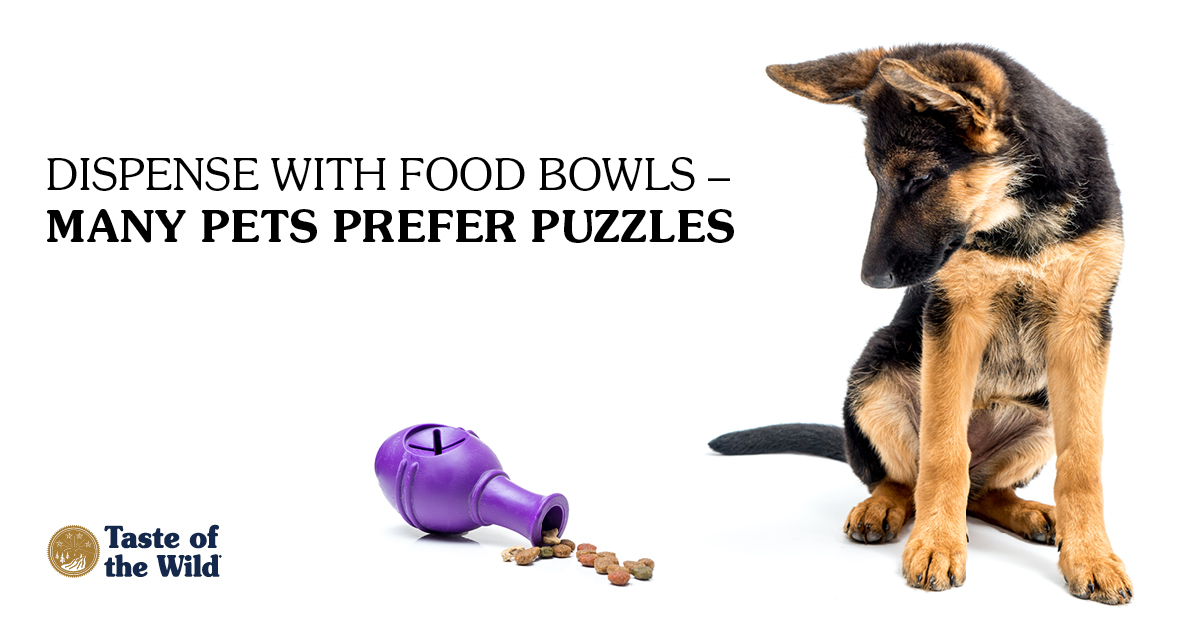
If we could be reincarnated, many of us would choose to return as a dog or cat. Why not? Snoozing on the couch all day…no nine-to-five job…regular belly rubs…no worries about where your next meal is coming from…what’s not to like?
But this “idyllic” life is a far cry from that of our pets’ wild ancestors, who usually spent the greater part of each day stalking, chasing and capturing their meals. By serving our pets a meal twice a day, we’re actually depriving them the thrill of the hunt.
This can make life very (yawn) boring. And a bored pet can become a stressed and destructive pet. In fact, this couch-potato life has no doubt contributed to an uptick in pet obesity and associated medical issues such as diabetes and arthritis. Boredom also contributes to stress, which can lead to unwanted behaviors such as excessive attention seeking and in cats, over-grooming and accidents outside the litter box.
One solution? Food puzzles.
Put Minds and Bodies Back to Work
As it turns out, most of our pets would rather have a job — working for food — because they have a natural instinct to forage for their meals. Food puzzles challenge their minds and provide an outlet to work off pent-up energy in a healthy way.
Essentially a toy filled with food or treats, food puzzles typically feature holes that dispense food when the pet manipulates it. Some are mobile, often shaped like a ball or tube that releases kibble as it’s rolled. Others are immobile and include sliding doors or channels where food can be fished out with a paw or tongue.
The puzzles are often adjustable, so as your pet masters the toy, you can reduce the size or numbers of openings to increase the challenge and keep your pet interested. While you’ll find a wide range of food puzzles online or at pet stores, you can also make your own. For example, just cut a few holes in an empty water bottle, fill it with kibble, replace the cap and let your pet have fun with it (under your supervision, of course).
The Many Benefits of Food Puzzles
While a food puzzle isn’t the entire cure for bored pets, it can help by providing a way to stimulate their minds, prolong meals and boost activity.
According to a recent study in cats, food puzzles, combined with behavior modification, provided numerous benefits, including weight loss, a reduction in attention-getting behavior, an end to accidents outside the litter box, as well as a decrease in aggression, fear and anxiety. Food puzzles have also been shown to reduce some behavior problems in dogs.
Start Slow, Be Patient
Think of food puzzles as a different delivery method for your pet’s meals rather than a way to provide additional treats. Start by placing a portion of your dog or cat’s daily food allotment in the food puzzle. As your pet learns to use the puzzle, gradually increase the amount of food dispensed until you no longer need the bowl.
At first, try introducing food puzzles around normal meal times, when your pet is more likely to be hungry. You’ll want to make it as easy as possible for your pet to obtain food from the puzzle so it’s a rewarding experience.
Use a puzzle with transparent or translucent sides so the pet can see and hear the kibble rattling inside. Sprinkle a little food around the puzzle to entice them to explore it.
If your pet doesn’t respond to one type of puzzle, try a different shape, texture or color (some pets just have different preferences). In the beginning, you may need to lure your pet with an especially delectable treat in the puzzle, and then gradually mix in food until that’s all that’s dispensed.
If you have multiple pets, isolate them with the puzzles so they can explore the toys without distraction and to prevent the dominant pet from getting all the food.
As your pet masters the food puzzle, gradually increase the challenge or switch to a different puzzle to keep them motivated. It’s a fun way to promote pet health and nutrition while forging an even stronger bond with your dog or cat.
The information in this blog has been developed with our veterinarian and is designed to help educate pet parents. If you have questions or concerns about your pet's health or nutrition, please talk with your veterinarian.
